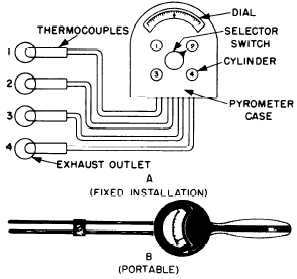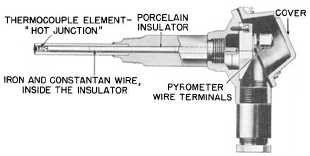75.170
Figure 3-5.—Pyrometers used in diesel exhaust systems.
terminals (see figure 3-6). A pyrometer (millivolt
meter) measures the voltage produced and shows
the results on a scale which has been calibrated
to read in degrees of temperature. In fixed installa-
tion pyrometers, if the connecting wires are of the
same type as those of the thermocouples, the ther-
mocouple element becomes, in effect, extended
to the pyrometer terminals and the temperature
at the meter (now the cold junction) becomes the
reference temperature. Then the selector switch
can be rotated to any cylinder and contact can
be made between the pyrometer and the hot junc-
tion. A reading can then be obtained for that par-
ticular point.
The hand-held pyrometer consists of an
indicator and a pair of pointed prods attached to
a sub-base and supported by a handle. To obtain
a reading, the prod points are pressed against the
exposed thermocouple terminals. The reading is
taken from the scale. A point to remember is that
the zero adjuster must be set to indicate room
temperature rather than 0° temperature.
GRAPHIC RECORDS
As you read in chapter 2, graphic records play
an important part in keeping an engine in proper
operating condition. When used properly they can
75.171
Figure 3-6.—Sectional view of a thermocouple.
tell you how your engine is performing and what
is happening inside the engine. Graphic records
indicate the overall condition of an engine and
warn you when certain parts are beginning to wear
out so that you may take prompt corrective ac-
tions and prevent major casualties.
ADJUSTMENT AND MAINTENANCE
An internal combustion engine is a com-
plicated machine, built with a high degree of preci-
sion throughout and capable of long dependable
service if it is kept in good operating condition.
To keep an engine in good operating condi-
tion you must perform all the adjustments and
maintenance prescribed in your installed PMS and
the manufacturers’ technical manuals. In this sec-
tion you will read about the adjustment and
maintenance of various components of an inter-
nal combustion engine.
AUTOMATIC REGULATING VALVE
In many engines, freshwater temperature is
regulated by an automatic regulating valve which
maintains the freshwater temperature at any
desired value by bypassing a portion of the water
around the freshwater cooler. An automatic
temperature regulator of the type commonly
used in the cooling systems of marine engines is
shown in figure 3-7. Even though these regulators
are automatic (self-operated), provisions are in-
cluded in most installations for manual operation
in the event that the automatic feature fails.
ENGINEMAN 1 & C
3-6




